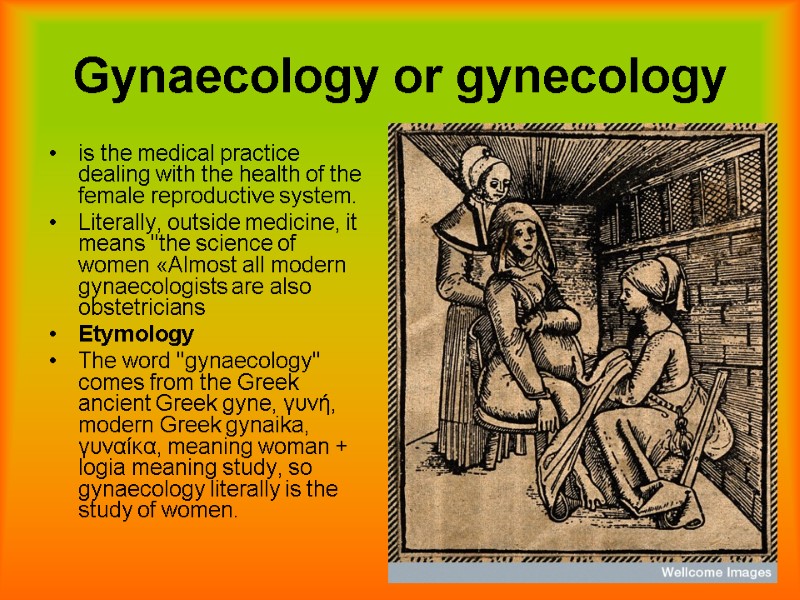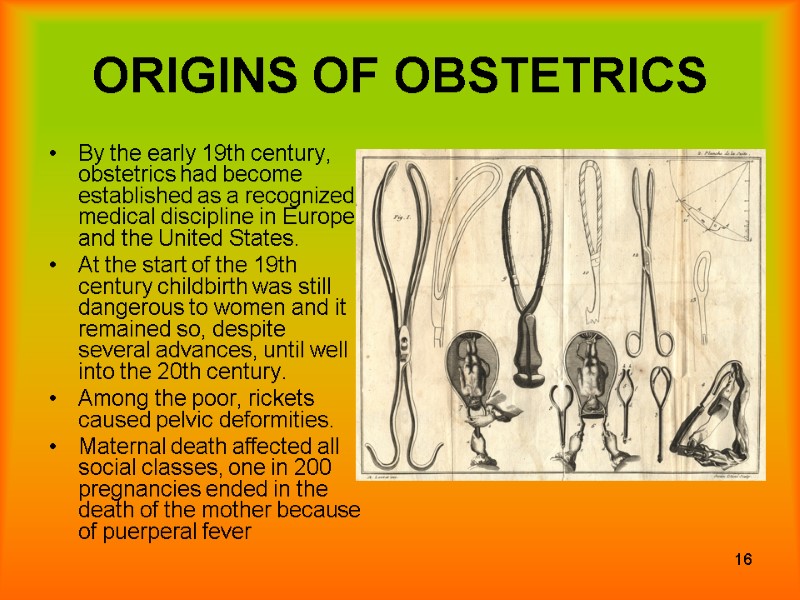1 Obstetrics and gynecology as subject. Organization of


1 Obstetrics and gynecology as subject. Organization of obstetric care. The main stages of obstetrics and gynecology development. Role of family doctor in the prevention of perinatal diseases and death. Lecture 1 Petrenko N.V., MD, PhD

2 Obstetrics and gynecology Obstetrics (from the Latin obstare, "to stand by") is the medical specialty dealing with the care of all women's reproductive tracts and their children during pregnancy (prenatal period), childbirth and the postnatal period.

3 Gynaecology or gynecology is the medical practice dealing with the health of the female reproductive system. Literally, outside medicine, it means "the science of women «Almost all modern gynaecologists are also obstetricians Etymology The word "gynaecology" comes from the Greek ancient Greek gyne, γυνή, modern Greek gynaika, γυναίκα, meaning woman + logia meaning study, so gynaecology literally is the study of women.

4 perinatology or Maternal-Fetal medicine (MFM) is the branch of obstetrics that focuses on the medical and surgical management of high-risk pregnancies. Obstetricians who practice maternal-fetal medicine are also known as perinatologists. This is a subspecialty to obstetrics and gynecology mainly used for patients with high-risk pregnancies.

5 obstetrics and gynecology medical/surgical specialty concerned with the care of women from pregnancy until after delivery and with the diagnosis and treatment of disorders of the female reproductive tract. The medical care of pregnant women (obstetrics) and of female genital diseases (gynecology) developed along different historical paths.

6 ORIGINS OF OBSTETRICS Gynecology as a branch of medicine dates back to Greco-Roman civilization, if not earlier. The renewal of interest in diseases of women is shown in the huge encyclopaedia of gynecology issued in 1566 by Caspar Wolf of Zürich. The earliest birth attendants were women. In ancient mythology, goddesses (but not gods) were present at deliveries. In “primitive” tribes studied by anthropologists in the last century, the labouring woman would be accompanied by her mother or other female relative. Prehistoric figures and ancient Egyptian drawings show women giving birth in the sitting or squatting position. Birthing stools and midwives are also mentioned in the Old Testament.

7 History The Kahun Gynaecological Papyrus is the oldest known medical text of any kind. Dated to about 1800 B.C., it deals with women's complaints—gynaecological diseases, fertility, pregnancy, contraception, etc. The text is divided into thirty-four sections, each section dealing with a specific problem and containing diagnosis and treatment, no prognosis is suggested. The Hippocratic Corpus contains several gynaecological treatises dating to the 5th/4th centuries BC. The gynaecological treatise Gynaikeia by Soranus of Ephesus (1st/2nd century AD) is extant.

8 ORIGINS OF OBSTETRICS The writings of Hippocrates in the fifth century BC include a description of normal birth. Instrumental delivery was restricted to stillborn babies and involved the use of hooks, destructive instruments, or compressive forceps. Such instruments were described in Sanskrit texts and were known in Arabia, Mesopotamia, and Tibet. Instrumental intervention in obstructed labour probably carried a high cost in terms of maternal mortality.

9 ORIGINS OF OBSTETRICS Soranus of Ephesus (AD 98–138) described antenatal care, labour, and the management of malpresentation by internal version and breech extraction. He advised that during labour a woman should be nursed in bed until delivery was imminent, and then moved to the birthing chair, when the midwife would sit opposite her, encouraging her to push, before receiving the baby on to papyrus or cloth. Soranus' writings formed the basis of the “Moschion”, a Latin manuscript in the sixth century AD, but little more was added to obstetric knowledge until the invention of printing 900 years later.

10 ORIGINS OF OBSTETRICS The history of obstetrics is inextricably linked with the history of midwifery. obstetrix was the Latin word for midwife: it is thought to derive from obstare (to “stand before”), because the attendant stood in front of the woman to receive the baby. Only in the 20th century did the subject taught in medical schools change its name from “midwifery” to “obstetrics”, perhaps because a Latin name seemed more academic than the Anglo-Saxon, derived from mid, “with”, and wyf, “woman”.

11 ORIGINS OF OBSTETRICS The first obstetric pamphlets were printed in Latin or in German in the latter part of the 15th century but made little impact. In 1513, however, an obstetric textbook appeared which became a bestseller. Der Schwangern Frauen und Hebamen Rosengarten, known as “The Rosengarten”, was translated into Dutch in 1516 and reprinted many times in Dutch and German over subsequent decades. It was also translated into several other languages, including French and English.

12 ORIGINS OF OBSTETRICS During the 16th century the great French military surgeon Ambroise Paré (1510–90) founded a school for midwives in Paris. Paré wrote about podalic version and breech extraction and about caesarean section, which he is said to have either performed or supervised not only after the death of the mother but also, at least twice, on living women. One of Pare's pupil midwives went on to attend the French court and one of the babies she delivered—a girl named Henrietta Maria—became Queen of England at the age of 16 when she married King Charles I in 1625.

13 ORIGINS OF OBSTETRICS Obstetrics had for a long time been the province of female midwives, but in the 17th century, European physicians began to attend on normal deliveries of royal and aristocratic families; from this beginning, the practice grew and spread to the middle classes. The invention of the forceps used in delivery, the introduction of anesthesia, and Ignaz Semmelweis’ discovery of the cause of puerperal (“childbed”) fever and his introduction of antiseptic methods in the delivery room were all major advances in obstetrical practice. Asepsis in turn made cesarean section, in which the infant is delivered through an incision in the mother’s uterus and abdominal wall, a feasible surgical alternative to natural childbirth.

14 ORIGINS OF OBSTETRICS The 18th century marked the beginning of many advances in European midwifery. These advances in knowledge were mainly regarding the physiology of pregnancy and labour. By the end of the century the anatomy of the uterus and the physiological changes that take place during labour began to be understood by medical communities. The introduction of forceps in childbirth also took place during the 18th century.

15 ORIGINS OF OBSTETRICS After Nufer, the first caesarean sections with survival of the mother were performed in Ireland by Mary Donally in 1738; in England by Dr James Barlow in 1793; and in America by Dr John Richmond in 1827. The “first” in the British Empire outside the British Isles was performed in South Africa before 1821 by James Miranda Barry, though in fact caesarean sections had been performed in Africa by indigenous healers for many years. All these operations, however, were performed without anaesthesia. In the mid-19th century death rates remained high and caesarean section was often combined with hysterectomy. In the 1880s, with the advent of asepsis, a conservative operation was developed and the “classical” operation—a vertical incision in the upper part of the uterus—became more frequently used. This incision does not heal well, however, and in 1906 the modern “lower segment” operation was introduced, which carries less risk of subsequent rupture.

16 ORIGINS OF OBSTETRICS By the early 19th century, obstetrics had become established as a recognized medical discipline in Europe and the United States. At the start of the 19th century childbirth was still dangerous to women and it remained so, despite several advances, until well into the 20th century. Among the poor, rickets caused pelvic deformities. Maternal death affected all social classes, one in 200 pregnancies ended in the death of the mother because of puerperal fever

17 The contagious nature of puerperal fever had been recognised by Alexander Gordon. Aberdeen experienced an epidemic of puerperal fever from 1789 to 1792, and Gordon published his Treatise on the Epidemic of Puerperal Fever in Aberdeen in 1795. He realised that the disease was transmitted from one case to another by doctors and midwives, and that there was a close relationship between puerperal fever and erysipelas (later found to be caused by the streptococcus). ORIGINS OF OBSTETRICS

18 Eventually others reached the same conclusion, including Oliver Wendell Holmes (1809–94), the American doctor and writer. Four years later, his Hungarian contemporary Ignaz Semmelweiss (1818–65), working in Vienna. Semmelweiss, concluded that cadaveric material caused infection, and he made his students wash their hands in chlorinated lime between the postmortem room and the labour ward. Within months during 1847 he reduced deaths in his unit to a level similar to that in the neighbouring midwife-led unit, where staff did not attend postmortems. ORIGINS OF OBSTETRICS

19 obstetrics and gynecology The two great advances that finally overcame such opposition and made gynecologic surgery generally available were the use of anesthesia and antiseptic methods. The separate specialty of gynecology had become fairly well established by 1880; its union with the specialty of obstetrics, arising from an overlap of natural concerns, began late in the century and has continued to the present day.

20 ORIGINS OF OBSTETRICS In the 20th century, obstetrics developed chiefly in the areas of fertility control and the promotion of healthy births. The prenatal care and instruction of pregnant mothers to reduce birth defects and problem deliveries was introduced about 1900 and was thereafter rapidly adopted throughout the world. Beginning with the development of hormonal contraceptive pills in the 1950s, obstetrician-gynecologists have also become increasingly responsible for regulating women’s fertility and fecundity. With the development of amniocentesis, ultrasound, and other methods for the prenatal diagnosis of birth defects, obstetrician-gynecologists have been able to abort defective fetuses and unwanted pregnancies. At the same time, new methods for artificially implanting fertilized embryos within the uterus have enabled obstetrician-gynecologists to help previously infertile couples to have children.

21 Perinatal/Maternal Mortality In the developed world, by contrast, in the second half of the 20th century attention shifted from the mother to the fetus. Two developments allowed this to happen. Fetal monitoring in labour became possible by detecting the fetal electrocardiogram and by sampling fetal scalp blood.
8796-01._obstetrics_and_gynecology_as_subject.ppt
- Количество слайдов: 21

